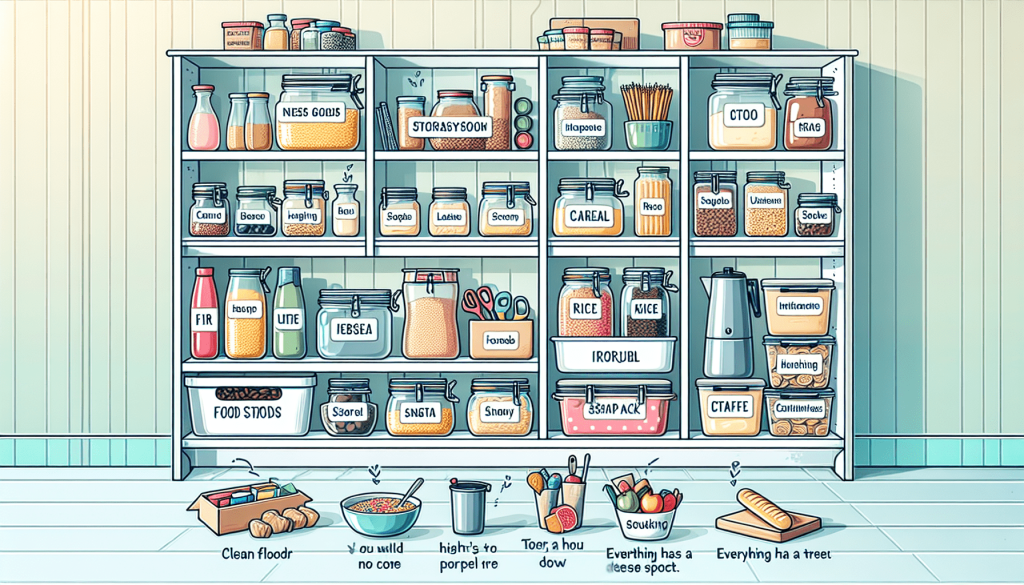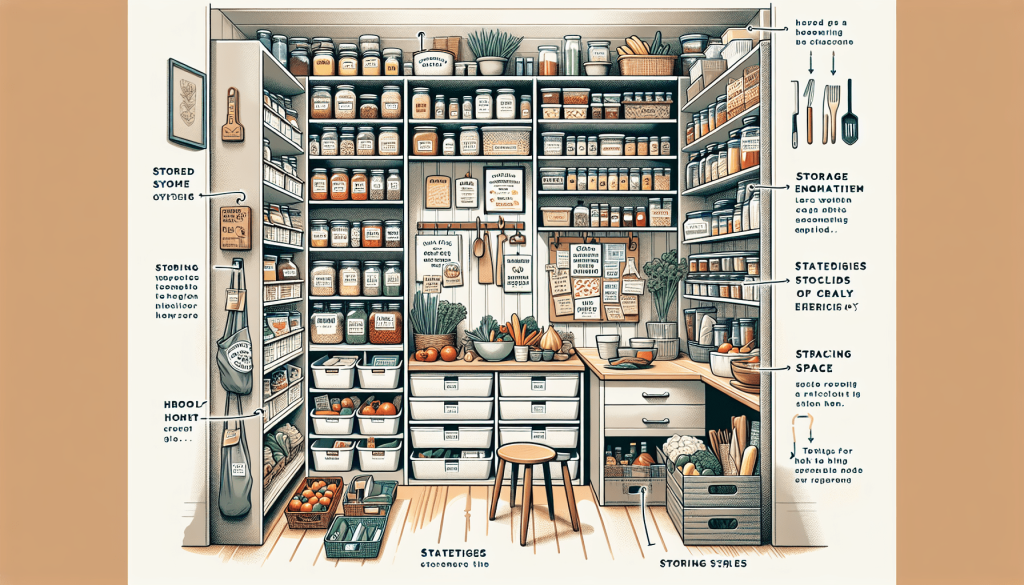So, you’ve decided it’s finally time to tackle that chaotic mess that is your pantry. Well, you’ve come to the right place! In this article, we’ll guide you through the process of setting up a well-organized pantry, ensuring that everything is easily accessible and neatly arranged. From decluttering and categorizing to investing in the right storage solutions, we’ll provide you with all the tips and tricks you need to transform your pantry into a functional and aesthetically pleasing space. Get ready to say goodbye to the days of rummaging through piles of cans and boxes, and say hello to a pantry that will make your life so much easier. Let’s get started, shall we?

Assess Your Space
Measure your pantry
Before you start organizing your pantry, it’s essential to measure the space you’re working with. Take note of the dimensions of your pantry, including the height, width, and depth. This will help you determine the best storage solutions for your specific space.
Determine your storage needs
Next, consider your storage needs. Take stock of the different items you typically store in your pantry, such as dry goods, canned goods, snacks, and spices. Think about how much space each category requires and how you can best accommodate them in your pantry.
Consider accessibility
When assessing your space, it’s crucial to think about accessibility. You’ll want to arrange your pantry in a way that makes it easy to find and reach for items. Consider how frequently you use certain items and ensure they are easily accessible. This will save you time and frustration in the long run.
Declutter and Clean
Remove all items from your pantry
To start fresh, remove all items from your pantry. This will allow you to clean the shelves thoroughly and assess each item before deciding whether to keep or discard it.
Sort and discard expired or unwanted items
As you empty your pantry, sort through each item. Check for expiration dates and discard anything that is expired or no longer needed. This will help free up valuable space and ensure that you only have fresh and usable items in your pantry.
Clean shelves, walls, and floors
While your pantry is empty, take the opportunity to clean every nook and cranny. Wipe down the shelves, walls, and floors to remove any dust, dirt, or spills. This will not only make your pantry look more attractive but also create a clean and hygienic environment for your food items.
Invest in Storage Containers
Choose airtight containers
Investing in airtight containers is a game-changer for organizing your pantry. These containers keep your food fresh and prevent them from becoming stale or attracting pests. Opt for containers with airtight seals to ensure maximum freshness for your pantry items.
Opt for clear containers
Using clear containers is another smart choice when it comes to pantry organization. Clear containers allow you to see the contents easily, making it effortless to locate items without rummaging through multiple containers. This saves you time and prevents frustration when you’re in a rush.
Label each container
To maintain a well-organized pantry, labeling each container is essential. Labeling not only helps you quickly identify items but also maintains a consistent organization system. Use a label maker or simply write on sticky labels to indicate the contents of each container.
Establish Zones
Categorize your pantry items
To create a well-organized pantry, start by categorizing your items. Group similar items together, such as baking ingredients, canned goods, snacks, and spices. This will make it easier to locate items when you need them.
Allocate separate zones for each category
Once you have categorized your items, allocate separate zones for each category within your pantry. For example, dedicate a shelf or section for baking ingredients and another for snacks. This will help maintain order and prevent items from getting mixed up.
Organize according to frequency of use
When arranging your pantry, consider the frequency with which you use each item. Place frequently used items at eye level or in the most accessible zones. Reserve higher or lower shelves for items that are used less often. This will make it easier to grab the items you need and keep your pantry organized.

Arrange for Visibility
Place frequently used items at eye level
To save time and ensure efficiency, place frequently used items at eye level. This eliminates the need to bend down or reach up to retrieve commonly used items. By keeping them at eye level, they are easily visible and readily accessible.
Stack items in a step-like formation
When it comes to organizing cans and jars, consider stacking them in a step-like formation. This way, you can see and access each item without having to move things around. Stacking items also helps maximize vertical space, allowing you to store more items in a smaller area.
Utilize lazy susans or pull-out shelves
Lazy susans and pull-out shelves are excellent additions to any well-organized pantry. They allow for easy access to items at the back of the shelf, ensuring that nothing gets lost or forgotten. Lazy susans are particularly useful for organizing spices or smaller items that tend to get jumbled.
Use Organizers and Dividers
Install pantry door organizers
Make use of the often-underutilized space on the inside of your pantry door by installing pantry door organizers. These handy organizers feature shelves, hooks, or pockets that can hold small items like spices, condiments, or snack packets. This not only maximizes space but also makes these items easily visible and accessible.
Utilize adjustable shelving
If your pantry shelves are not adjustable, consider investing in adjustable shelving units. These allow you to customize the height of each shelf to accommodate different-sized items. Adjustable shelves are particularly useful for taller items such as cereal boxes, bottles, or larger jars.
Use drawer dividers
If your pantry has drawers, utilizing dividers can help keep them organized. Drawer dividers are perfect for separating smaller items like chips or snacks, preventing them from getting mixed up or buried beneath larger items. Dividers also make it easier to see what you have in each drawer at a glance.
Maximize Vertical Space
Install vertical storage racks or hooks
To make the most of your pantry’s vertical space, consider installing vertical storage racks or hooks. These can be mounted on the inside or outside of your pantry door, providing additional storage for items such as cutting boards, baking sheets, or aprons. Vertical storage racks are a fantastic solution for freeing up valuable shelf space.
Utilize the top shelves for lesser used items
Often, the top shelves of a pantry are underutilized. Take advantage of this space by storing lesser used or bulkier items on the higher shelves. Items like large cereal boxes, paper towels, or extra bottles can be stored here, keeping your frequently used items easily accessible at eye level.
Hang baskets or wire racks
For additional storage options, hang baskets or wire racks from the ceiling of your pantry. These can hold lightweight items like bread, fruits, or bags of chips. Hanging baskets or wire racks not only maximize storage but also add visual interest and make your pantry feel more organized.
Implement a First-In-First-Out System
Rotate your pantry items regularly
To ensure that you are always using the freshest products, implement a first-in-first-out system. When restocking your pantry, place newer items behind older ones. By doing this, you will naturally use the older items first, preventing any items from going bad or expiring.
Place newer items behind older ones
When you purchase new items, be mindful of where you place them in your pantry. Always put newer items behind older ones to ensure that you are using the older items first. This simple practice helps reduce waste and keeps your pantry stocked with fresh ingredients.
Label items with purchase dates
To maintain an efficient first-in-first-out system, consider labeling items with their purchase dates. This is particularly useful for perishable items or those with expiration dates. Be sure to place the labels in a visible location, so you can easily keep track of how long each item has been in your pantry.
Maintain a Shopping List
Designate an area for a shopping list
To stay organized and avoid running out of essential items, designate an area in your pantry for a shopping list. Attach a small whiteboard or notepad to the inside of your pantry door, where you can jot down items as they run out. This ensures that you never forget what you need to buy.
Regularly update the list as items run out
As items in your pantry are consumed, make it a habit to update your shopping list promptly. This prevents you from forgetting anything and saves you from making multiple trips to the grocery store. By consistently updating your shopping list, you’ll always know what needs to be replenished.
Take the list with you when you go shopping
When you’re ready to do your grocery shopping, don’t forget to take your shopping list with you. This way, you can easily refer to it and ensure that you pick up all the items you need. Having a shopping list also helps prevent impulse purchases and keeps you focused on your meal planning.
Regularly Clean and Reorganize
Set a schedule for pantry maintenance
To maintain a well-organized pantry, it’s important to set a schedule for pantry maintenance. Choose a frequency that works for you, whether it’s once a month or once every few months. Regularly cleaning and reorganizing your pantry will help you stay on top of any clutter or expired items and maintain a functional space.
Clean and organize pantry at least once a month
As part of your pantry maintenance routine, make it a point to clean and organize your pantry at least once a month. This includes wiping down shelves, checking for expired items, and reorganizing any items that may have been misplaced. Regular maintenance ensures that your pantry remains in top-notch shape all year round.
Make adjustments based on changing needs
Lastly, be open to making adjustments to your pantry organization. As your needs change or new items are introduced into your pantry, don’t hesitate to reevaluate your system. Being flexible and adaptable will allow you to create a pantry that suits your specific needs while maintaining an organized and clutter-free space.
Setting up a well-organized pantry takes a bit of effort and planning, but the results are rewarding. By assessing your space, decluttering and cleaning, investing in storage containers, establishing zones, arranging for visibility, using organizers and dividers, maximizing vertical space, implementing a first-in-first-out system, maintaining a shopping list, and regularly cleaning and reorganizing, you’ll have a pantry that is efficient, visually appealing, and a joy to use. So roll up your sleeves, grab some storage containers, and get ready to transform your pantry into a well-organized space that will simplify your meal preparation and make your daily routine a breeze. Happy organizing!
